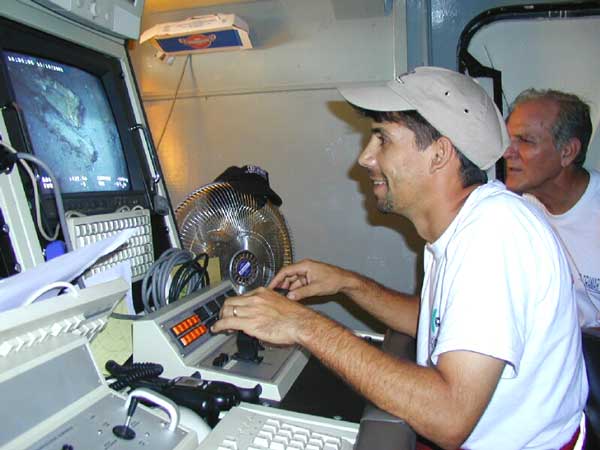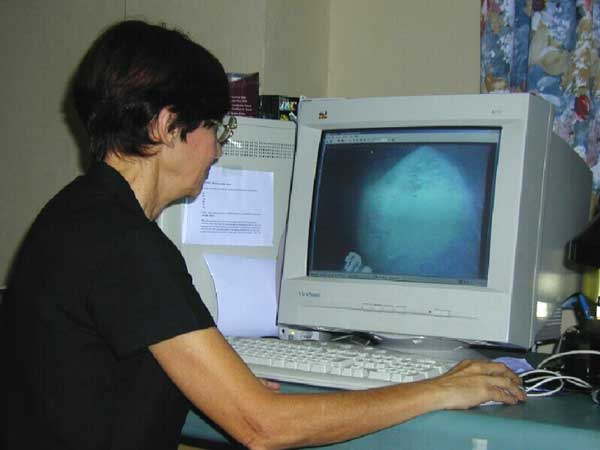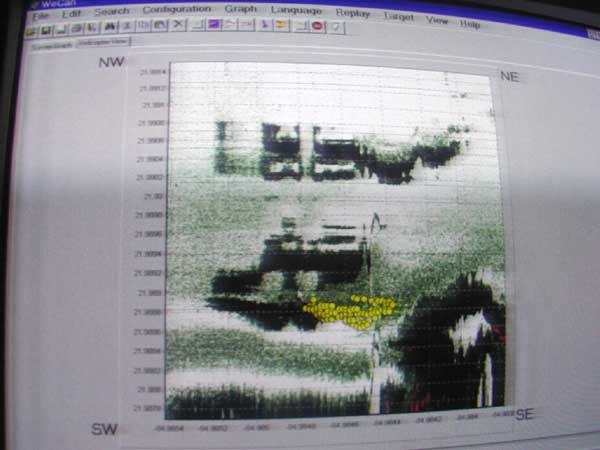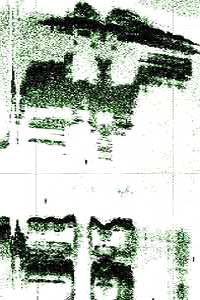|
text translation service for many worldwide languages
page six of the high resolution images from the Morien Institute interview with – Dr Paul Weinzweig – Advanced Digital Communications Havana, Cuba
On December 12 2001 the Cuban newspaper, “Granma” reported that during the previous summer, ADC had filmed ruins of a possible ‘Lost City’ submerged off the coast of the Guanahacabibes Peninsula, on the western tip of Cuba in the Yucatan Channel. It quoted ocean engineer, Paulina Zelitsky, of ADC as cautioning that the nature of their discovery is not yet fully understood, and that they would return in January 2002 to conduct further investigations:
“It’s a marvelous structure which could possibly have been a great urban center … However, it would be completely irresponsible to to say what it is, before having all the evidence.”
an ADC crew member ‘flying’ the ROV from the controls on the ‘Ulises’ research vessel, with archæologist,
ADC – Havana, Cuba –
Below, Paulina Zelitsky of ADC looks at the video image of a ‘pyramid-shaped structure’ that the ROV had sent back to one of the dedicated computers on board the ‘Ulises’. “Granma” reported that researchers have pointed out the mysterious structures could have been at least 6,000 years ago, 1,500 years before the first pyramids on the Giza plateau in Egypt. Paulina Zelitsky told them that the structures, presumably built on dry land before being covered by the sea, could have been sunk by volcanic activity in the area. It also told that, in July 2000, ADC researchers had identified an area 650 metres deep, where symmetrically organised stone structures that resembled an urban layout, were clearly visible:
“That footage confirms the presence of large blocks of granite in circular and perpendicular formations. Most of the blocks, between two and five meters long, were not covered. Others were covered with sediment and the area’s fine white sand.”
ADC – Havana, Cuba –
The computer screen below shows one of the original ‘sidescan sonar’ images from the July 2000 ADC expedition. On December 28 2001, a report by Reuters featured on Linda Moulton Howe’s “Earthfiles” website, where Paulina Zelitsky was quoted as saying that ADC has high resolution sidescan sonar images of:
” … a huge land plateau with clear images of what appears to be manmade large-size architechural designs partly covered by sand. From above, the shapes resemble pyramids, roads and buildings.”
ADC – Havana, Cuba –
One of the many ‘sidescan sonar’ images of part of the megalithic complex discovered by ADC. Using a growing array of sophisticated underwater equipment, which includes the ROV, such images are facinating archæologists and geologists around the world. As ADC‘s investigations progress, it will be interesting to see if any of the roadways, or the axis orientation of any of the major structures, points in the direction of the ‘Old North Pole’, which during the last Ice Age was at 60° North, 73° West, in the Hudson’s Bay area …
ADC – Havana, Cuba –
“We believe that much of the significant archaeology of the future will be discovered in the little-explored world’s oceans and will greatly expand our understanding of the enormous antiquity of human civilization.”
Dr Paul Weinzweig, June 12 2002, Havana, Cuba
back to the interview with Dr Paul Weinzweig
|




